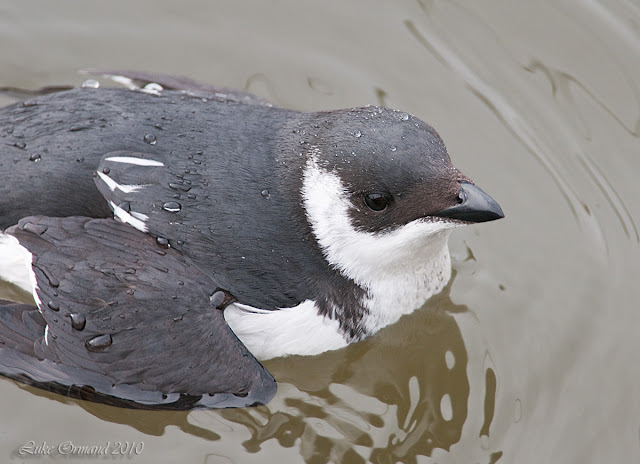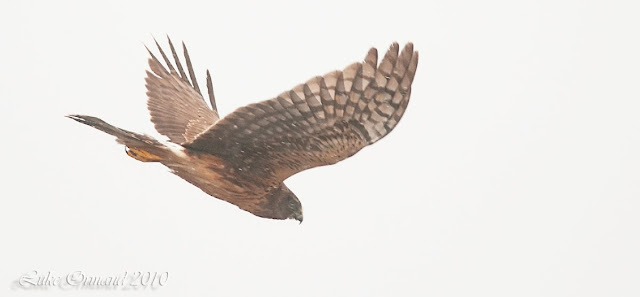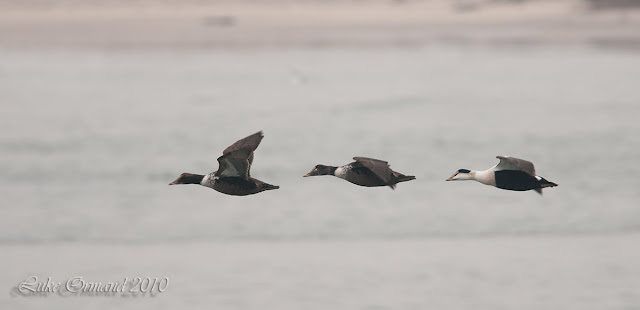I went to see the Dovekie for a second time and when I left Westhampton it was clear blue skies (albeit, quite cold). When I had driven about 5 miles the blue sky was gone - replaced by awful grey clouds which would remain for the rest of the day, absolutely ruining any hopes of improving of my Dovekie portoflio. The only hope I had was for some interesting behavior (diving shots, preening shots, etc.) but even those shots would be difficult as getting proper exposure and lighting on the eye (by far the most important [fundemental] factor in wildlife photography) without the sun shining is near impossible (save for using an external flash). Another concern with photographing the bird today was the potential for ice as the temps had dipped well below freezing and virtually all creeks and ponds on the island had froze over night. Much to my delight, the marina is equipped with aerators (air compressors connected to rubber hoses with holes in them that allow for air bubbles to escape under the water around pilings, thus keeping them from freezing and becoming damaged) so ice was not an issue. The bird however, was very active and spent the majority of its time moving up and down the marina, diving constantly and swimming underwater in pursuit of fish. As the water is quite shallow you can follow the bird underwater as a trail of bubbles gives away its location. This became immediately frustrating and I spent quite a bit of time in my car waiting for the Dovekie to make its way back toward me instead of chasing it up and down.
Patience Pays, Reward is a Video:
Just as I was ready to leave, I saw 3 people gathered in one spot for about a minute and thought maybe the Dovekie had finally settled down so I pulled up and got out and sure enough it was done diving for the moment and decided to putt putt around and preen itself. Finally a photo op. Sadly, 90% of my photos are so backlit or at a poor angle that the eye isn't visible. I did take the opportunity to make a short video of the Dovkie so all of you who have not seen it in person can appreciate how cute and amusing it is. What's really great about the video is the compressor can be heard running which makes it seem as though there is a motor attached to this little guy (girl?). What's NOT so great about this video, is it's a little shaky. . . alas I need a tripod if I'm going to get into filming wildlife!
Capture?
After I had been photographing it at close range for some time (and freezing in the process) a woman arrived and stated she was an Avian Biologist (I have no reason to doubt her, and I surmise that she works for the State or Federal Gov., though she was not in uniform or driving an official vehicle). She briefly inquired about its behavior over the last few days, then stated that this is not normal behavior (obviously) and that it looked stressed. Some other people who were present informed her that it had been diving and moving up and down the Marina all morning and only now settled down but she didn't seem to care and exclaimed "I'm going to catch it, it's stressed". (Okay, I'm not a biologist [I did major in Marine Biology for 2 years though, if that counts for anything?] but if the bird is ALREADY stressed, don't you think catching it with a giant net will exacerbate this? Not to mention, it's a DIVING bird so. . .) The biologist returned to her car and got on the phone (I presume with a supervisor or other avian expert) and at this moment the Dovekie started to dive again. Well, I wasn't about to sit and watch her try to catch this bird (although it may have been amusing) and from later reports this afternoon no one mentioned an interaction with her and all accounts are that the bird was still there.
It is not looking good for this bird as the temperatures have dropped significantly and the water is quite cold. It certainly is lucky it found a location that did not ice over, but the cold may get to the bird eventually (though it SEEMS to be quite successful in eating). Only time will tell.

























































